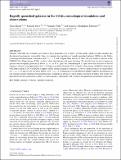Rapidly quenched galaxies in the Simba cosmological simulation and observations
Date
06/2022Metadata
Show full item recordAbstract
A wide range of mechanisms have been put forward to explain the quenching of star formation in galaxies with cosmic time, however, the true balance of responsible mechanisms remains unknown. The identification and study of galaxies that have shut down their star formation on different timescales might elucidate which mechanisms dominate at different epochs and masses. Here we study the population of rapidly quenched galaxies (RQGs) in the SIMBA cosmological hydrodynamic simulation at 0.5<z<2, comparing directly to observational post-starburst galaxies in the UKIDSS Ultra Deep Survey via their colour distributions and mass functions. We find that the fraction of quiescent galaxies that are rapidly quenched in SIMBA is 59% (or 48% in terms of stellarmass), which is higher than observed. A similar "downsizing" of RQGs is observed in both SIMBA and the UDS, with RQGs at higher redshift having a higher average mass. However, SIMBA produces too many RQGs at 1<zq<1.5 and too few low mass RQGs at 0.5<zq<1. The precise colour distribution of SIMBA galaxies compared to the observations also indicates various inconsistencies in star formation and chemical enrichment histories, including an absence of short, intense starbursts. Our results will help inform the next generation of galaxy evolution models, particularly with respect to the quenching mechanisms employed.
Citation
Zheng , Y , Dave , R , Wild , V & Rodríguez Montero , F 2022 , ' Rapidly quenched galaxies in the Simba cosmological simulation and observations ' , Monthly Notices of the Royal Astronomical Society , vol. 513 , no. 1 , pp. 27–41 . https://doi.org/10.1093/mnras/stac905
Publication
Monthly Notices of the Royal Astronomical Society
Status
Peer reviewed
ISSN
0035-8711Type
Journal article
Description
Funding: YZ acknowledges support of a China Scholarship Council - University of St Andrews Scholarship. FRM is supported by the Wolfson Harrison UK Research Council Physics Scholarship. RD acknowledges support from the Wolfson Research Merit Award Program of the UK Royal Society.Collections
Items in the St Andrews Research Repository are protected by copyright, with all rights reserved, unless otherwise indicated.

